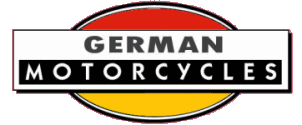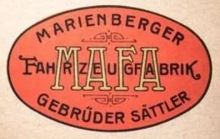


This page lists brand names beginning with the letter "M" for which we currently have only an historical precis. See also the List of German Motorcycles.
Mabret
Max Bretschneider and his partner E. Krupper ran a motorcycle shop in Elmsbüttel in the early 1920s.
Krupper left the business, and in 1926 Bretschneider began building Mabret motorcycles powered by 346 sidevalve and OHV Kühne engines, and sometimes a twin-port OHV 500cc unit was fitted. Most had chain drive, but some early models were belt drive to the rear wheel.
A 600cc machine was advertised in the early 1930s, powered possibly by a Bark engine.
Sources: Tragatsch p197; Motopedia.
Maco
Using DKW two-strokes and 198cc sidevalve engines of their own the firm built motorcycles from 1921 to 1926.
Source: Tragatsch p197
Mada Autino 1947-1949

Mafa
Marienberger Fahrzeugfabrik Gebrüder Sättler KG, an established bicycle manufacturer, built motorcycles from 1923 to 1927.
Rudolf and Johannes Sättler advertised their first motorcycle throughout Germany, aimed at the burgeoning tax-free sector for lightweights. The machine was powered by a 143cc DKW two-stroke with belt drive and a light blue petrol tank. The same engine was fitted to models added to the 1924 range, the Sport and the Racing, both of which were frequently mentioned in reports on regional sports events.
The lightweight with similar specification was released as the Model 25 for the 1925 season, and was joined by the Model K 25 fitted with an OHV Kühne 348cc engine, a three-speed gearbox and chain drive. The K25 remained in the catalogue until 1927.
Blackburne and Barr & Stroud engines were also used for their 350cc machines, and another model used the OHC Kürchen.
Production ended in 1927.
Sources: Tragatsch p197; Motopedia.
Maifa
Manufactured by Maier-Fahrzeuge.
The illustration is believed to be an advertisement to test buyer reaction, and the machine did not achieve production.
Mailhammer Sidecars 1980~1998
Maiwald, Mascottchen
Manufactured by Neuköllner Maschinenfabrik, 1952-1953
Address: Berlin SO 36 Köpenicker Str. 147
This was a small scooter with a 50cc engine. Apparently it was underpowered and failed to find buyers.
Source: GTU Oldtimerservice
Mallon
Sportmotorräder + Motoballzubehör manufactured by Jonny Mallon of Meinerzhagen, near Cologne.
Advertised in 2025 are Motoball models K2 (98cc AX100), M4 and M4a (Rotax 250cc Type 257), and M6 (TM 250).
Sources: François-Marie Dumas, mallon-motorsport.de
More on the sport of Motoball.
Mammut (Bielefeld)
There were three marques of this name built in Germany, as well as the Munch Mammut. Two were built in Bielfeld.
In 1924-1929 Hermann Froböse of Mammut-Fahrrad-Werke GmbH, Bielefeld, produced a 249 cc two-stroke motorcycle with a Baumi engine.
Between 1953 and 1956 Mammut mopeds with 50 cc JLO, Zündapp and Sachs engines 50cc were produced. These were identical to mopeds sold by Meister and Phanomen, which were also based in Bielefeld.
Sources: GTU Oldtimerservice, owl.museum-digital.de
Mammut 1925-33 (Nuremberg)
Mamof
Built a lightweight motorcycles using DKW 145cc and Grade two-strokes along with their own 155cc sidevalve engines from 1922 to 1924.
Source: Tragatsch p201
Manderbach 1925-1960
Marz Sidecars
Zweirad-Technik Ferdinand März
St. Vither Str. 43, 54595 Prüm / Niederprüm, Germany
Four sidecars in the program: Variablo Touring, Variablo Roadster, Klappino, Alpino.
The firm also offers an extensive range of accessories for the Yamaha V-Max.
Source: gespanne-f-maerz.de
Mas
Limited production of lightweights with 183cc two-stroke engines, 1923-1924.
There was a well-established Italian marque of the same name.
Source: Tragatsch p202
Maasch
Manufactured by Ernst Maasch, Berlin SO., Wrangelstr. 112, 1904
The marque was possibly named "ZIEL".
Zwerad-Motoren und Motor-Zweirädern.
Address also listed as Berlin SO., Mariannenstrasse 31—32
Source: contemporary literature
Matador
Manufactured by C. Klose, Staßfurt, 1924-1926
Well-received by the motorcycle press the firm offered two models, the second of 269cc with a tubular frame. Inflation made it impossible to continue and they closed in 1926.
Source: GTU Oldtimerservice
Maurer 1922-1926
MAW 1950s, DDR
Mawi 1923-1930
Max
Manufactured by Auto-Motor-Industrie GmbH in Berlin, 1924-1925
The firm produced 180cc two-stroke and 446cc sidevalve single-cylinder motorcycles.
Source: GTU Oldtimerservice, Tragatsch p205
Maybach 1886
Mayrette 1924-33

Mega Machines
The firm manufactured motorcycles using Chevrolet 350 cui V8 engines from 1997 to 2024.
Website: megamachines.de
Meteor 1924-1926 (Two different makes)
Merco
Manufactured by Mercur Motoren GmbH, Berlin 1922-1924
Also marketed as the Record, these motorcycles had frames built by Hugo Gruhn and engines from Franz Krause.
Source: GTU Oldtimerservice
Merkur
Located in Quickborn / Holstein, the firm manufactured cargo tricycles from 1929 to 1939. There were several models which were fitted with their own engines. The engines were sold to other manufacturers including Demmo in the Dutch East Indies.
Possibly related to the Mercur aircraft company of Berlin (Merkur Flugzeugwerke). See Dobro-Motorist.
Source: Automobilia 85-45
Meybein 1922-1926
Meybra
In 1925 Motorenwerk Bayreuth, Georg Meyer built motorcycles powered by an OHV 250cc engine with a two-speed gearbox and kickstarter. The machine bore a resemblance to the Sunbeam from England. Tragatsch writes that they were powered by their own 168cc two-stroke engines,
Production probably did not extend into the 1926 season.
Sources: Tragatsch p208; Motopedia.
Meyfa 1950s
M.F.
Manufactured by Max Fischer, Nuremberg-Johannis, 1922 - 1926
The factory built motorcycles using 492cc BMW boxer engines, and 347cc and 497cc side-valve singles from Blackburne.
Source: meisterdinger.de
N.B. There was also an M.F. built in France by Louis Boccardo.
MFB
Manufactured by Gerhard W. Lehmann & Co., Hamburg, 1923-1924, who also built automobiles. The motorcycles had wooden frames and used 198cc Nabob and 293cc SV JAP engines.
Hoco of Minden continued construction after M.F.B. ceased trading.
Source: Tragatsch (p208)
N.B.
1. 1922-1923 are dates given by another source.
2. There is also a post-WWII Italian marque of the same name: MFB, and a German sidecar manufacturer of the 1950s named MFB (see Falke). Yet a third MFB was "Motorfahrzeugbau GmbH, Hamburg" which designed and built the predecessor models of Hoco and possibly also the Elite lightweight motorcycles. (motopedia-online.info)
MFZ 1921-1928
MGF
Manufactured by Mühlbauer & Co., Berlin, 1923-1931
The firm specialised in high-performance two-stroke engines based on the Ruppe / Bekamo principle which were sold in large numbers to other motorcycle manufacturers.
They built belt-drive motorcycles, both with compressors, of 140cc and 175cc. When production of these ceased they continued making accessories.
Source: GTU Oldtimerservice
M.G.H. Heilbronn 1927~1939
Mielke
Felix Mielke built racing machines based on the BMW R75 fitted with a Fiat Topolino 500cc engine from 1947 to 1951.
Source: GTU Oldtimerservice

Mimoa
Manufactured by Mittelbadische Motorradfabrik, Bruno Felber & Son, Achern, Baden
The machine was displayed at the Stuttgarter Motorradausstellung (Stuttgart Motor Show) of 1924 (Stand 141), and it was mentioned in the press two or three times that year. Competition results indicate that the machine was entered in the under 500cc class, calling into doubt the use of Rohöl (crude oil) engines from Julius Löwy engines as stated by Tragatsch.
The Felber company ceased to exist in 1925.
Sources: Tragatsch p211; Motopedia.
Miranda
Built in Dortmund by Pirol Werke GmbH, 1951-1954
Introduced in 1949 as the JLO-powered Schweppe, the Miranda used 150cc Sachs and 200cc Kurchen engines.
See also Schweppe
Source: GTU Oldtimerservice, Tragatsch p211
MJ
1925. Built HO twins of 596 and 746cc which they supplied to other manufacturers including Heller. The Mehne firm purchased the company when it encountered difficulties. MJ also built an interesting two-stroke motorcycle which did not enter production.
Source: Tragatsch p211
M.J.S.
Manufactured by Schönfeld & Schwarz, Nuremberg
The factory produced limited numbers of motorcycles with 245cc two-stroke engines. Possibly also known as N.I.S.
Source: meisterdinger.de
MKM
Manufactured by M. Kralapp Motorfahrzeugfabrik of Magdeburg in 1924.
These were tax-free lightweights of 2 hp and 2.5 hp, believed to have been powered by two-stroke 125cc and 131cc Grade engines.
Source: Motopedia
MKW
Manufactured by Anton Jais of Münchener Kraftrad Werkstätten, 1924.
Anton Jais retailed tyres, accessories and a variety of spare parts, and had workshops which produced castings and enameling. He specialised in foreign machines, particularly "English Triumphs", and also traded in complete motorcycles from Germany and abroad.
Early in 1924 the firm offered "MKW" motorcycles which were basically Coventry Triumph Model H machines assembled from components crafted in-house along with imported Triumph parts.
Sales were slow, and the company was disolved in September 1925.
Source: Motopedia
MMM
Motorenwerk München-Mannheim AG produced limited numbers of 136cc (possibly 148cc) two-stroke motorcycles 1925-1927, which were also offered under the brand name MD.
Sources: Tragatsch p212; Motopedia.
Mofa
Built 70cc and 148cc bicycle attachment engines along with complete motor bicycles from 1920 to 1925.
Source: Tragatsch p212
Mohr Sidecar
At the "Fahrrad- und Automobil-Ausstellung" (Bicycle and Automobile Exhibition) in Berlin in September 1905, the August Mohr company from Ilmenau (Thuringia) displayed a "particularly useful innovation" - a sidecar. This was an open seat (presumably wicker) that was bolted to the motorcycle.
Source: fahrtraum.at
Mohr
In the 1960s and 1970s Alfons Mohr of Hausen (am Nürburgring) built 50cc racing machines, among them Mohr-Kreidler and Mohr-Derbi.
Sources: kreidler-winkelmann.de, et al
MON
Manufactured by Maschinenfabrik Oberndorf Neckar in Oberndorf, 1953-1955
Mopeds powered by 50cc Rex engines.
Source: GTU Oldtimerservice
Monos 1924~1929
Mops 1924-1925
Mota Wiesel 1948-52
Motorist
Manufactured by Dobron-Motorist GmbH of Berlin, 1923-1925
The first model used a DKW 150cc two-stroke engine, followed by a JAP 350cc model. The machine was also marketed as the Dobron Motorist.
Source: GTU Oldtimerservice
Motor-Treibrad
Manufactured by Luftfahrzeug Gesellschaft of Berlin, an aircraft company, shortly after the end of World War One. In 1919 they built a Fahrrad-Hilfsmotor in the form of a powered trailer which pushed a bicycle, thus putting the cart before the horse.
Source: period advertising
Motowig Sidecars 1992-2000
Möve
Manufactured by Walter & Co. in Mühlhausen, 1903-1908
Also known as the Möwe, these motorcycles were fitted with Fafnir 3.5 hp single-cylinder engines and 5 hp V-twins.
Source: GTU Oldtimerservice
Mozet
Mozet Apparatebau, Alexanderstraße 11, Leipzig, manufactured sidecars 1929 to 1934.
Using steel bodies the firm offered sports sidecars along with convertible touring versions with sliding windows, and sidecar compartment heating via the exhaust.
Source: projekt-eindruck-le.de
Müco
Active 1921-1924, the Muco firm built bicycle attachment engines of 118cc which were fitted adjacent to the rear wheel.
Source: Tragatsch p222
Müller-Gespanne
Mueller/Sauer-Gespannbau has been in business for over 40 years. When her partner Peter Sauer died in 2020, Elsbeth Mueller, an ardent sidecar rider, assumed management of the firm.
Sidecar models and marques include:
Source: sauer-sidecar.de
Mufag of Hanover 1950s
Mufi (Imperator)
Built a basic motorcycle with 348cc three-port deflector piston two-stroke in 1925-26.
Source: Tragatsch p222
MWR
Mathias Winekls was bicycle manufacturer around 1950 from Mönchengladbach Rheydt.
An example has a Sachs engine, probably 50cc. MWR logo on tank and headstock. Has pedals. Ladies model with dropped frame, valanced guards and chainguard. Rather pretty.
Source: Farben-Schiessl
Rarer German Marques